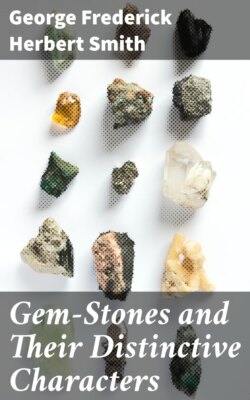Читать книгу Gem-Stones and Their Distinctive Characters - George Frederick Herbert Smith - Страница 16
На сайте Литреса книга снята с продажи.
Absorption Spectra
ОглавлениеTable of Contents
A study of the chromatic character of the light transmitted by a coloured stone is of no little interest. As was stated above, the eye has not the power of analysing light, and to resolve the transmitted rays into their component parts an instrument known as a spectroscope is needed. The small ‘direct-vision’ type has ample dispersion for this purpose. It is advantageous to employ by preference the diffraction rather than the prism form, because in the former the intervals in the resulting spectrum corresponding to equal differences of wave-length are the same, whereas in the latter they diminish as the wave-length increases and accordingly the red end of the spectrum is relatively cramped.
The absorptive properties of all doubly refractive coloured substances vary more or less with the direction in which light traverses them according to the amount of dichroism that they possess, but the variation is not very noticeable unless the stone is highly dichroic. If the light transmitted by a deep-coloured ruby be examined with a spectroscope it will be found that the whole of the green portion of the spectrum is obliterated (Fig. 31), while in the case of a sapphire only a small portion of the red end of the spectrum is absorbed. Alexandrite affords especial interest. In the spectrum of the light transmitted by it, the violet and the yellow are more or less strongly absorbed, depending upon the direction in which the rays have passed through the stone (Fig. 31), and the transmitted light is mainly composed of two portions—red and green. The apparent colour of the stone depends, therefore, upon which of the two predominates. In daylight the resultant colour is green flecked with red and orange, the three principal absorptive tints (cf. p. 235), but in artificial light, which is relatively stronger in the red portion of the spectrum, the resultant colour is a raspberry-red, and there is less apparent difference in the absorptive tints (cf. Plate XXVII, Figs. 11, 13).
Fig. 31.—Absorption Spectra.
In all the spectra just considered, and in all like them, the portions that are absorbed are wide, the passage from blackness to colour is gradual, and the edges deliminating them are blurred. In the spectra of certain zircons and in almandine garnet the absorbed portions, or bands as they are called, are narrow, and, moreover, the transition from blackness to colour is sharp and abrupt; such stones are therefore said to display absorption-bands. Church in 1866 was the first to notice the bands shown by zircon (Fig. 31). Sorby thought they portended the existence of a new element, to which he gave the name jargonium, but subsequently discovered that they were caused by the presence of a minute trace of uranium. A yellowish-green zircon shows the phenomenon best, and it has all the bands shown in the figure. The spectrum varies slightly but almost imperceptibly with the direction in the stone. Others show the bands in the yellow and green, while others show only those in the red, and some only one of them. The bands are not confined to stones of any particular colour, or amount of double refraction. Again, many zircons show no bands at all, so that their absence by no means precludes the stone from being a zircon.
Almandine is characterized by a different spectrum (Fig. 31). The band in the yellow is the most conspicuous, and is no doubt responsible for the purple hue of a typical almandine. The spectrum varies in strength in different stones. Rhodolite (p. 214), a garnet lying between almandine and pyrope, displays the same bands, and indications of them may be detected in the spectra of pyropes of high refraction.
PLATE IV
JEWELLERY DESIGNS
